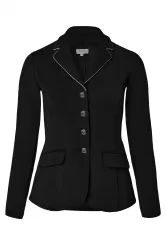Common elements of riding apparel
2023-11-24
Riding apparel is specialized clothing designed for horseback riding, providing comfort, safety, and functionality for both the rider and the horse. The type of riding apparel may vary depending on the discipline, weather conditions, and personal preferences. Here are common elements of riding apparel:
Riding Helmets:
1. Helmet:
- Safety: A well-fitted riding helmet is a crucial safety item, protecting the rider's head in case of a fall or impact.
Upper Body Apparel:
2. Shirts:
- Breathable Fabrics: Riding shirts are often made of moisture-wicking and breathable fabrics to keep the rider comfortable.
3. Show Jackets:
- Formal Attire: In certain equestrian disciplines, riders wear formal show jackets for competitions.
4. Vests and Body Protectors:
- Additional Protection: Some riders choose to wear vests or body protectors for additional impact protection.
Lower Body Apparel:
5. Breeches or Jodhpurs:
- Comfort and Grip: Riding pants designed for comfort in the saddle, often with reinforced areas for better grip.
6. Chaps and Half Chaps:
- Leg Protection: Chaps or half chaps provide additional protection for the rider's legs and help improve grip.
7. Riding Boots:
- Foot Support: Purpose-designed boots provide ankle support and protect the rider's feet in the stirrups.
8. Socks:
- Moisture-Wicking: Riding socks made of moisture-wicking materials help keep the feet dry and comfortable.
Gloves:
9. Riding Gloves:
- Grip and Protection: Gloves provide grip on the reins and protect the rider's hands from friction.
Outerwear:
10. Jackets and Coats:
- Weather Protection: Depending on weather conditions, riders may wear jackets or coats for warmth and protection.
11. Rain Gear:
- Waterproof Clothing: Waterproof jackets and pants help keep riders dry in wet weather.
Accessories:
12. Hats and Caps:
- Sun Protection: Wide-brimmed hats or caps provide shade and protect from the sun.
13. Stock Ties and Riding Stocks:
- Formal Attire: Worn in certain equestrian competitions as part of formal riding attire.
Safety Gear:
14. Reflective Gear:
- Visibility: Riders may use reflective gear for increased visibility, especially when riding in low-light conditions.
15. Safety Vests:
- High-Visibility: Some riders, especially those involved in eventing or trail riding, wear high-visibility safety vests.
Specialized Apparel:
16. Show Shirts:
- Formal Wear: Show shirts are designed for formal competitions and often feature a clean and polished look.
17. Riding Tights:
- Comfort and Flexibility: Tights are designed for comfort and flexibility, providing a close fit to the body.
18. Base Layers:
- Moisture Management: Base layers are designed to manage moisture and keep the rider comfortable in various weather conditions.
Considerations:
- Safety Certification: When choosing riding helmets, ensure they meet safety standards and are certified by relevant authorities.
- Fit: Proper fit is crucial for safety and comfort. Riding apparel should allow freedom of movement and prevent chafing or discomfort.
- Discipline-Specific Gear: Some disciplines may have specific requirements for riding apparel. Always check the rules and regulations of the particular equestrian discipline or competition.
- Weather Conditions: Consider the weather conditions when choosing apparel. In hot weather, breathable fabrics are essential, while waterproof gear may be necessary in rainy or cold conditions.
- Durability: Riding apparel should be durable and able to withstand the wear and tear associated with horseback riding.
Selecting the right riding apparel ensures a comfortable and safe riding experience. Riders should choose gear appropriate for their riding style, discipline, and environmental conditions.



